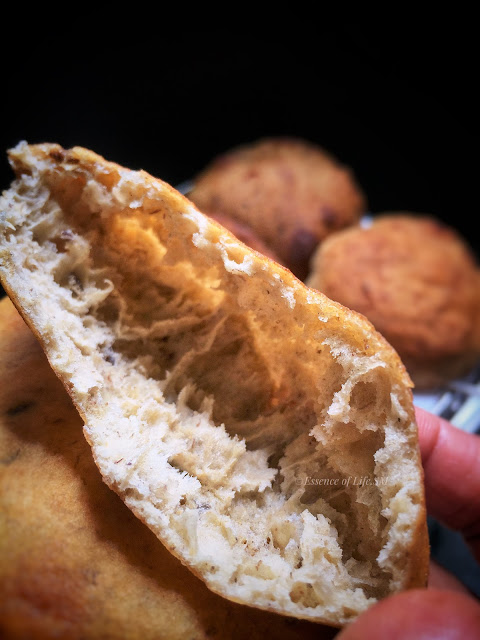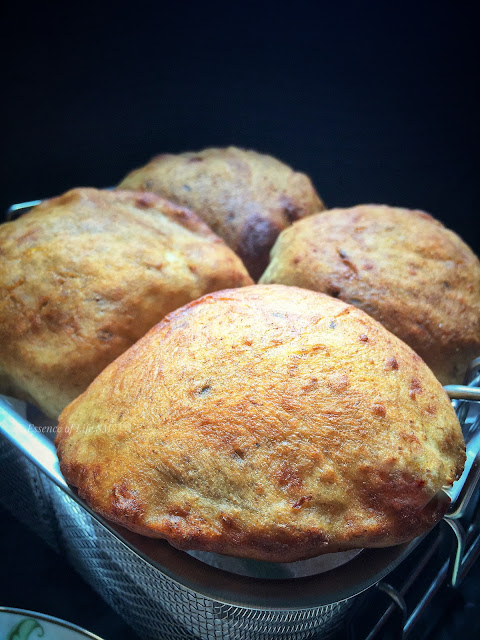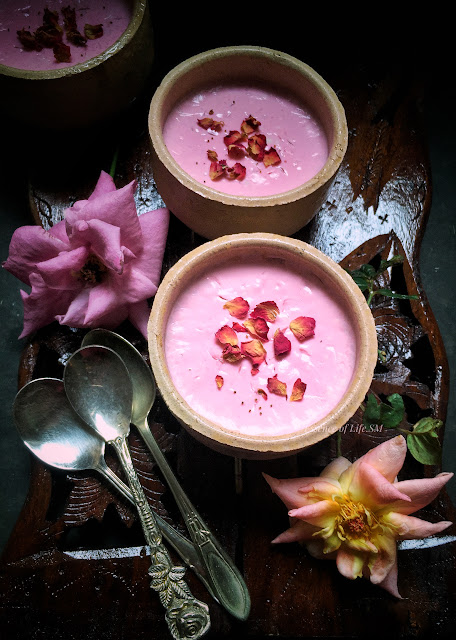 |
| SALT |
I have always wondered how humans got to know about different types of tastes. The wonder of a tongue is indeed prodigious. The brilliance of a human mind to identify an ingredient and then its taste and use it in such a way to enhance food has always kept me in awe since my childhood days. The idea, how a human might have eaten food without salt or spice, still intrigues me.
Humans might have recognised the tastes from naturally grown fruits and vegetables, and then how was salt found? In terms of Salt, History could be written as - animals wore paths to salt licks; men followed; trails became roads, and settlements grew beside them. And in due course, when the human menu shifted from salt-rich to cereals, more salt was needed to supplement the diet. Salt deep inside the earth (underground deposits) were beyond reach, and the sprinkle of salt deposits over the surface was insufficient. Scarcity made the mineral PRECIOUS.
World History states that Salt is one of the first international commodities of trade. The production of Salt should have been one of the first industries and, inevitably, the first state monopoly. The stuff that makes our food tasty has struck wars, trade conflicts, riots and covenants between warlords, kings, countries, rulers and even God.
 |
| SALT |
“With all thine offerings, thou shalt offer salt,” says Leviticus in the Old Testament. As it is used as a preservative, salt became a token of permanence to the Jews. It turned out to be an eternal covenant between God and Israel. Salt has a long run bloody pathway in terms of its evolution.
My memory with Indian History and Salt travel back to the lessons we learnt about the Dandi March and the Vedharanyam Uppu Sathyagraha Porattam (struggle for Salt). It was one incident which turned the course of India’s history.
Well, currently it is just an ingredient, easily available and must-have in each and every kitchen hold.
Salt enhances, enlivens & compliments the very essence & taste of food. Salt intensfies & balances the flavours. As a Tamil saying goes, "Uppilla Pandam Kuppayile," which means, "Food without salt is worth the bin". Whether sweet or savoury, salt plays an important role in cooking. It takes dishes from just tasty to delicious, suppresses bitterness, and helps preserve food. It dehydrates fleshy tissues, speeding up the drying process. Salt is used in curing and pickling. Along with it Salt has non-edible uses too, it is also used for de-icing the pavements etc.,
In India, salt is considered as Lakshmi, the goddess of wealth & prosperity. When someone shifts to a new house, the first thing to be taken into the house is salt, followed by turmeric and water. It is considered to be auspicious, a belief followed by the locales for time immemorial.
Technically, all salt is sea salt—even table salt, which is mined from rocks of Halite that were formed by ancient water bodies. In spite, not all salts are the same and each salt has its own way of usage.
As a child, I knew just one salt - the rock like salt cystals which were then commonly used in almost every Indian kitchen. Here, I have come up with a few Salts I commonly use in my kitchen and also these type of salt happens to be widely used ones in Indian Cuisine. I have personally seen an evolution of the usage of Salt in my so far, short lifetime. Let me put it up as a timeline through my memory lane in terms of my acquaintance with this humble and equally precious mineral Salt.
Sea Salt
 |
| SEA SALT |
During my childhood, in late 70s & early 80s, there were vendors who used to sell Salts in push carts. The most common Salt variety then - Kal Uppu or the Rock Salt or the Sea Salt Crystals. We could even see the grocery shops displaying them in a big sack in front of the store. Then not many had the awareness of table salt or not many used it in regular basis in their kitchen.
During our trip to Tuticorin (Thoothukudi), in my early age, I was literally fascinated to see huge Salt
beds or salt pans colloquially called Uppalam. Where salt is harvested from Seawater. The huge Salt beds with salt crystals glistened in the hot temperature, and I wondered how the men toiled around in that hot sun. I was even told that they would have blisters in their hands and legs as they walk through the Salt pans to collect the Salt. Though Salt, the Crystals tend to cut through their skin while harvesting them.
Sea Salt or the Rock Salt are harvested from evaporated seawater, sea salt can be either very salty or lightly salty, depending on where it's harvested & depending upon the type of minerals found in that particular area. Sea salt also contains loads of minerals, so it can have an intricate flavour. Sea salt is unrefined, it contains more minerals like potassium, zinc, magnesium, calcium, and iron. It helps in enhancing the flavour of the dish.
Sea salt does not dissolve easily. And also these type of Salt tends to clump/cake together easily.
Table Salt

TABLE SALT

Whether you're sitting at home, in a table at your local restaurant, or in a fancy restaurant, chances are a pair of salt and pepper shakers are within reach. You can always find a Salt and Pepper Shaker on the table, which made me assume that hence these type of Salt was called Table Salt. But I'm still not sure...
Table Salt is the most common kind of salt used in India. It is commonly called as Iodized Salt in India. Where unbranded Salt was a norm in Indian market, there came a trend of high-quality, vacuum -evaporated salt, more hygienic and healthy.
The evolution of Iodized Salt found its path into Indian kitchen in late 80s and the government of India made sure that it should reach every kitchen by 1992. The propagation and marketing of Iodized Salt which simply marked as an incredible solution to Iodine deficiency which leads to Goitre (thyroid gland issues). The idea of adding Iodine to table salt proved remarkably easier and the best method to get rid of Iodine deficiency. Easiest way to provide Iodine supplement is to mix it with table salt.
The Doordharshan Advertisement, which showed Tata Salt as "Desh ka Namak" (Country's Salt). And even the name Table Salt got to be called as Tata Salt by Indian housewives.
Black Salt -Kala Namak
 |
| BLACK SALT - KALA NAMAK |
Black Salt is a dark, reddish-black crystalline salt that turns a grey to pinkish colour when ground up. It has a distinct, sulphurous odour and taste. Kala Namak has a stronger and more pungent flavour. Also, these natural salts have a small amount of other minerals as well as a higher moisture content, so it has less sodium than processed salt.
Himalayan Pink Salt

HIMALAYAN PINK SALT

Well, the latest propagation of eating healthy in every term, brought forth to the acquaintance of Himalayan Pink Salt. As sceptical as ever, thinking too deep whether it is truly good or purely marketed, kept me from buying it, until my daughter bought a pack of Himalayan Pink Salt.
Later, reading about it gave me an idea about the salt and the only benefit of this particular variety is it is considered to be the most natural salt, than table salt. Himalayan salt is less artificial and does not usually contain additives. These Himalayan Pink Salts are not refined and also do not have any anti-caking agents to prevent clumping. And it has a bold flavour.
Himalayan Pink Salt is the purest of all salt & is harvested from the Khewra
Salt Mine in the Himalayan Mountains of Pakistan. Easily recognizable
because of its pink colour, Himalayan Pink Salt comes in various colours due to the presence of predominant mineral content in their
natural state. It contains all 84 natural minerals
found in the human body.
 |
| HIMALAYAN PINK SALT |
Kosher Salt
 |
| KOSHER SALT |
It is nothing but a coarse edible salt, but it got to be named in various terms in various countries & cultures. The term Kosher Salt came to called commonly in North America, referring to its use in Jewish religious practice of dry Brining meats, known as "Koshering".
Kosher salt has become the ubiquitous term for coarse salt. It is flaky and has longer grains. Its texture is light but coarse, and it dissolves easily. It does not contain any additives like iodine. And also has less sodium content. If you are using just one salt in your pantry, then opt for kosher salt.
The cure for anything is Salt - Sweat, Tears or the Sea, as the quotes go... A pinch of Salt and the difference it makes to a dish is what it is valued for... But too much of it can literally damage your health. Sodium is necessary in small quantities and conciously consuming low sodium diet can keep us healthy.





































